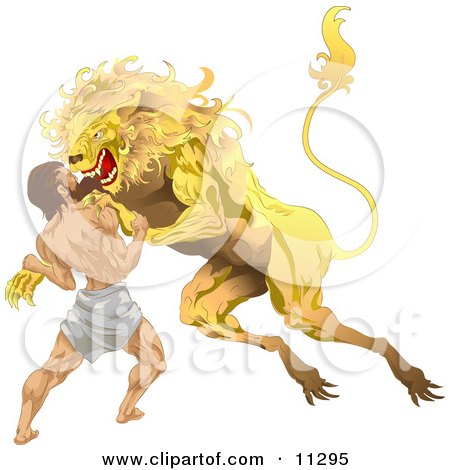



Hercules is the Roman name for the mythical Greek demigod Heracles, son of Zeus (the Roman Jupiter) and the mortal Alcmena. Early Roman sources suggest that the imported Greek hero supplanted a mythic Italian shepherd called "Recaranus" or "Garanus", famous for his strength. While adopting much of the Greek Heracles' iconography and mythology as his own, Hercules adopted a number of myths and characteristics that were distinctly Roman.
In Roman works of art and in Renaissance and post-Renaissance art that adapts Roman iconography, Hercules can be identified by his attributes, the lion skin and the club: in mosaic he is shown tanned black, a virile aspect. While he was a champion and a great warrior, he was not above cheating and using any unfair trick to his advantage. However, he was renowned as having "made the world safe for mankind" by destroying many dangerous monsters. His self-sacrifice obtained him the ascent to the Olympian realms and he was welcomed by the gods.
Hercules later married Deianira, whom he won from the river god Achelous. When the centaur Nessus attacked Deianira, Hercules wounded him with an arrow that he had poisoned in the blood of the Hydra. The dying centaur told Deianira to take some of his blood, which he said was a powerful love charm but was really a poison. Believing that Hercules had fallen in love with the princess Iole, Deianira later sent him a tunic dipped in the blood. When he put it on, the pain caused by the poison was so great that he killed himself on a funeral pyre. After death he was brought by the gods to Olympus and married to Hebe, goddess of youth.
Hercules was worshiped by the Greeks as both a god and as a mortal hero. He is usually represented as strong and muscular, clad in a lion skin and carrying a club. The most famous statue of the mythical hero is in the National Museum in Naples.
In Roman works of art and in Renaissance and post-Renaissance art that adapts Roman iconography, Hercules can be identified by his attributes, the lion skin and the club: in mosaic he is shown tanned black, a virile aspect. While he was a champion and a great warrior, he was not above cheating and using any unfair trick to his advantage. However, he was renowned as having "made the world safe for mankind" by destroying many dangerous monsters. His self-sacrifice obtained him the ascent to the Olympian realms and he was welcomed by the gods.
Hercules later married Deianira, whom he won from the river god Achelous. When the centaur Nessus attacked Deianira, Hercules wounded him with an arrow that he had poisoned in the blood of the Hydra. The dying centaur told Deianira to take some of his blood, which he said was a powerful love charm but was really a poison. Believing that Hercules had fallen in love with the princess Iole, Deianira later sent him a tunic dipped in the blood. When he put it on, the pain caused by the poison was so great that he killed himself on a funeral pyre. After death he was brought by the gods to Olympus and married to Hebe, goddess of youth.
Hercules was worshiped by the Greeks as both a god and as a mortal hero. He is usually represented as strong and muscular, clad in a lion skin and carrying a club. The most famous statue of the mythical hero is in the National Museum in Naples.





0 comments:
Post a Comment